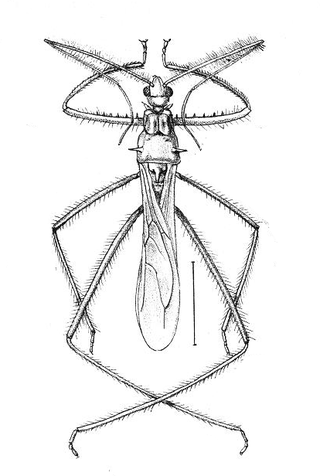
The Reduviidae is a large cosmopolitan family of the order Hemiptera. Among the Hemiptera and together with the Nabidae almost all species are terrestrial ambush predators; most other predatory Hemiptera are aquatic. The main examples of nonpredatory Reduviidae are some blood-sucking ectoparasites in the subfamily Triatominae. Though spectacular exceptions are known, most members of the family are fairly easily recognizable; they have a relatively narrow neck, sturdy build, and a formidable curved proboscis. Large specimens should be handled with caution, if at all, because they sometimes defend themselves with a very painful stab from the proboscis.

The Emesinae, or thread-legged bugs, are a subfamily of the Reduviidae. They are conspicuously different from the other reduviids by their very slender body form. They are stalking, predatory insects that can be collected on palm fronds, cliffs, spider webbing, or near lights at night. They walk on their mid and hind legs; the front pair is raptorial. Some groups specialize on spiders. Very little is known about emesines except that many species are found in the tropics. Pedro Wygodzinsky wrote the most recent revision of this group.

The Harpactorinae are a large subfamily of the Reduviidae. About 300 genera and 2,000 species worldwide have been described. Some of the species of the genera Zelus, Pselliopus, Sinea, and Apiomerus are of interest as biological pest control agents.

Stenolemus is a genus of thread-legged bug (Emesinae). Species of this genus are noted for preying on spiders.
Gardena is a genus of thread-legged bugs in the subfamily Emesinae. It is the second-largest genus in the tribe Emesini. Presently there are 46 described species.
The Metapterini are a tribe of thread-legged bugs, assassin bugs of subfamily Emesinae.

Emesopsis is a genus of tropical bugs (Heteroptera) from the family Reduviidae. There are at least 22 described species, of which one, E. nubila, also occurs in southern Europe.
Onychomesa is a little-known genus of thread-legged bug in the subfamily Emesinae. Three species have been described, one from India, Japan, and Taiwan.

The Ectrichodiinae are a subfamily of assassin bugs (Reduviidae) known for specializing on millipedes as prey. The group comprises more than 600 species in about 115 genera, making it a fairly large subfamily. The bugs are also known for their aposematic coloration, often brightly colored metallic blue, red, or yellow.

Sphedanolestes is a large genus of assassin bugs in the family (Reduviidae), subfamily Harpactorinae. There are more than 190 described species, which are found in southern Europe, Africa and Asia.

The Stenopodainae are a subfamily of Reduviidae. Many species of this subfamily are endemic to tropical rainforests, and some smear their fore legs with sticky, plant-derived resin, to aid in prey capture.

The Reduviinae are a subfamily of the reduviid assassin bugs. Many members of the subfamily are nocturnal and their lifecycles are generally poorly known. This subfamily is suspected not to be monophyletic.
The Peiratinae are a subfamily of assassin bugs (Reduviidae) known as corsairs. The subfamily has a worldwide distribution, but is concentrated in tropical areas. About 30 genera with 350 species are described.
Saicella is a genus of assassin bugs endemic to Hawaii. There are currently six species in the genus. Saicella's taxonomic position is uncertain, with characters similar to both the Saicinae and Emesinae subfamilies.

Saicinae is a subfamily of the family Reduviidae, or the assassin bugs.

LopodytesRondani 1867 is a genus in the family Reduviidae, the assassin bugs. Members of the genus have been unofficially assigned the common name grass assassin bugs, but generally this name remains meaningful only to naturalists, because these insects have been too well camouflaged to raise robust public awareness.
Microtominae is a subfamily of assassin bugs in the family Reduviidae. There are at least 2 genera and about 19 described species in Microtominae.
The Dicrotelini are a tribe of assassin bugs in the subfamily Harpactorinae. Originally described by Carl Stål, genera and species have been recorded from Asia and Australia.

Salyavatinae are a subfamily of the assassin bugs. They have a pan-tropical distribution with about 16 genera. They have two foretarsal segments and have a patch of fine hairs known as the fossula spongiosa on the fore and mid tibia. Many species tend to have spines on the head, pronotum, legs and abdomen. A few species have the foretibia flattened into leaf-like structures.
Dalytra spinifex is a species of assassin bug in the subfamily Harpactorinae.










